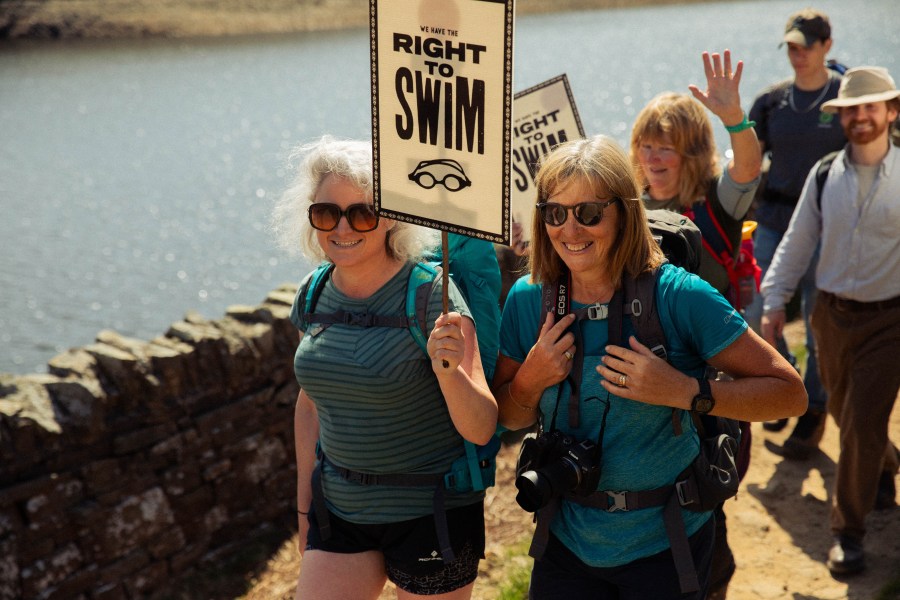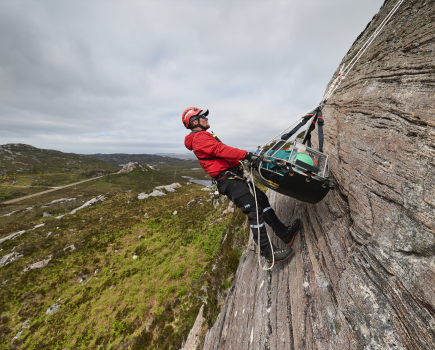Two figures waved vigorously at us. From afar they looked like tiny dolls, standing as they were on the path overlooking Kinder Reservoir. They were security guards of some sort, clad in high-visibility jackets which looked a bit warm for the weather. Around four hundred of us waved back, most of us bobbing in the water as we did so. They were waving for us to get out, but we’d only just waded in and we were having a good time of it.
Main image: Kinder Mass Trespass attendees | Credit: Crusoe Weston
“Come in, the water’s great!” “Hello!” “Join us!” went the cries from the assemblage – part joy, part jeer. Four hundred strong, signs were held aloft featuring slogans like “Right to swim!” and “How else am I supposed to cool my flaps?”.
Fifteen minutes earlier we’d all marched in a snaking column up the hill, past one of those same security guards, one of whom had been lounging on the sloped lawn of the reservoir wall. I’d waved to him, and he’d waved back, possibly a bit puzzled by what was going on: not an unusually large Ramblers’ group, but a mass trespass protesting the fact that we lack a clear legal right to swim in the waters of England and Wales. Reservoirs represent a significant portion of England’s large bodies of water, with over 2,000 of them scattered around the country. They can be idyllic, as Kinder Reservoir is, in the crook of the Peak’s highest peak.

Through trespass on foot and more recently, by water, the Kinder Massif has been a focal point of the fight for access to Britain for nearly a century, and the waters of its reservoir are an attractive prospect for the ever-growing number of outdoor swimmers in the UK. Reservoirs are typically much cleaner than other bodies of water further downstream. There is a profit motive for landowners to keep them that way, in stark contrast to the many other excrement-flushed (largely by water companies) watercourses and beaches of Britain.
Elsewhere, in the Chew Valley, Staunton Harold Reservoirs and beyond, many others were donning their trunks to protest what they saw not just as an infringement of their rights, but also a failure of water companies to meet their statutory duties to promote public access. The way to the water was barred by an array of signs declaring “NO SWIMMING”, and would-be swimmers were greeted by a chorus of tutting from BBC news anchors and newspapers. Why? Because it’s dangerous.
Reservoirs, we are told, are “active operational sites, containing deep cold water, and hidden hazards beneath the surface”. Water companies declare some version of this ad nauseam in response to calls for access. Let’s dive a little deeper on the dangers of reservoir swimming and the way we purport to keep the public safe from it.
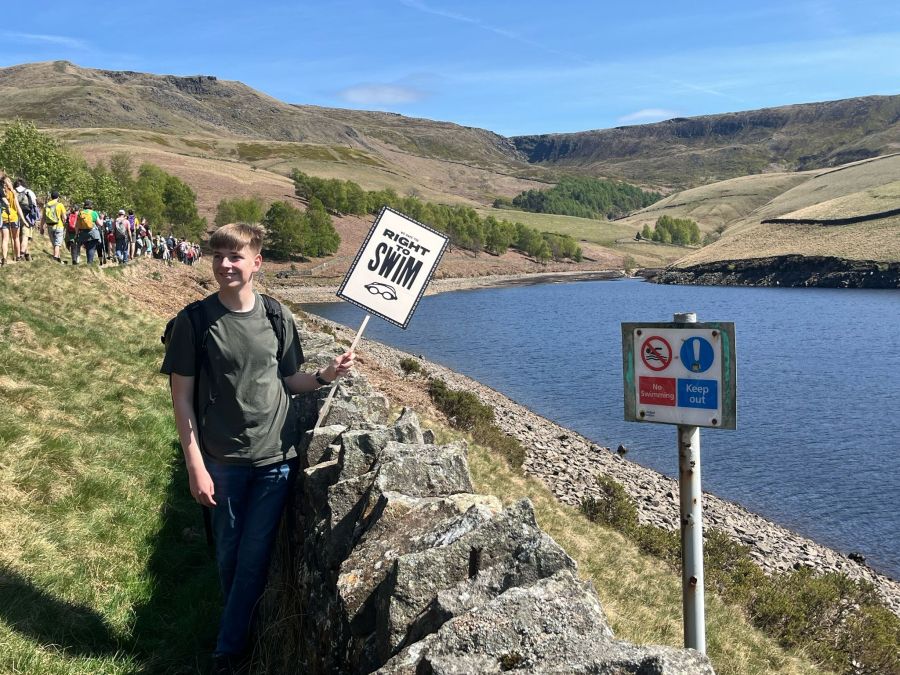
Nearly all of our reservoirs in the UK today are managed with hostility towards bathing as a form of recreation. Fear is the strategy of deterrence, with forbidding signs and rhetoric. Nonetheless, many of them are regularly enjoyed by rule-breaking swimmers. One might imagine that it would serve the public interest then, to get a little more specific about these ‘hidden dangers’? Why not try to reveal them? One might imagine that for a reservoir the size of, say, Kinder (44 acres) there might be some areas of open water which are more or less safer than other parts?
If I were the reservoir safety manager and truly wished to avoid litigation protect public health, a more useful tactic than vaguely shouting “but don’t you know water’s dangerous! And… Uh… Cold!” might be to cordon off dangerous areas, or better yet, highlight safe areas for swimming. It’s not news that water can be hazardous – everyone knows this. Simply informing a person of that fact does not inform the decision making of someone who intends to swim. The ocean features riptides, currents, sharks and ‘deep water’ (up to a dizzying 10,924 meters), but millions of us take a dip in the big blue every time the sun shines.

Among the dippers in Kinder was Phill Brickell, MP for Bolton West, a keen kayaker and parliament’s foremost advocate for a right to roam. He asked the packed crowd at Hayfield Green an obvious question: “If it’s good enough in Scotland, why is it not good enough in England?!” (in Scotland, there is a right to swim which includes reservoirs). “If the water’s not too cold, I tell you what, I’ll be going for a dip, and I hope many of you will join me” (and he did). We are told that Scotland is different, that their right to roam wouldn’t work here. But surely water is water? You can influence behaviour in ways which don’t involve adding to the national sign assemblage.
In Sweden, where rights and responsibilities are at the core of their culture, there is a different semiotic approach. On the granite coastline of Bohuslän there were hazards aplenty – jagged rocks, cold (!) water, often deep, occasionally shallow. They deployed something extremely powerful to divert the public away from these dangers: a warm welcome. Diving boards, slipways, jumping towers, ladders, and signs inviting the public in. “SWIM, JUMP, DIVE, BUT NO SOAP” read one small notice on a wooden plank nailed to a tree by a pond. Together with the locals, we leapt off rocks, doing somersaults into the cold (!!!) murky water. Being invited in is something that an English or Welsh person in our public spaces doesn’t often get to experience, certainly not into water.
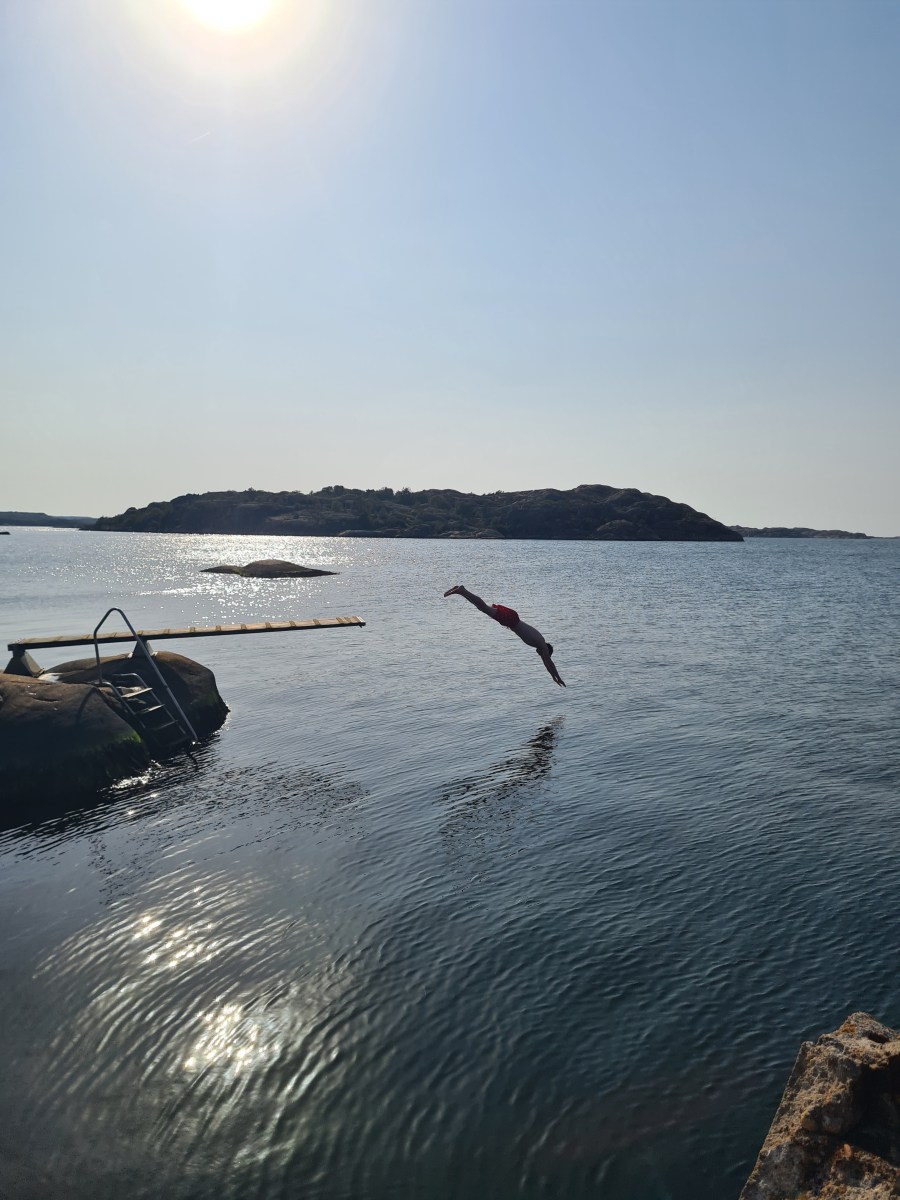
Another way is possible – but frankly I’m done being lectured about the dangers of water (however cold or deep) by companies who themselves wreak such destruction on our public health and that of our rivers. I think we can be forgiven for ignoring the pearl-clutching of those who are in part responsible for the fact that not one river in England is in good overall health. Access to water is a matter of public health and bloviating about risks while doing nothing to address them isn’t good enough.
The blanket exclusion of the public from reservoirs and other inland water harms us and erodes trust: people do not tend to abide by rules which they perceive to be morally unjust. Our own experiences in the water tell us that many of these signs lie to us about the true level of danger. There are signs on Thirlmere Reservoir which claim that the water there ‘rarely rises above freezing’. Rarely rises above freezing!
If a wild swimmer did happen upon a sign that was telling the truth, it would be such an exception as to be dismissed as just another false cry of “Wolf!”. But there were no wolves, metaphorical or otherwise, in the brown depths of Kinder reservoir that Sunday. Only four hundred swimmers of all ages, from all parts of the UK, celebrating a freedom they didn’t exactly have, in water that was admittedly cold (!) and in places, deep (!!!).
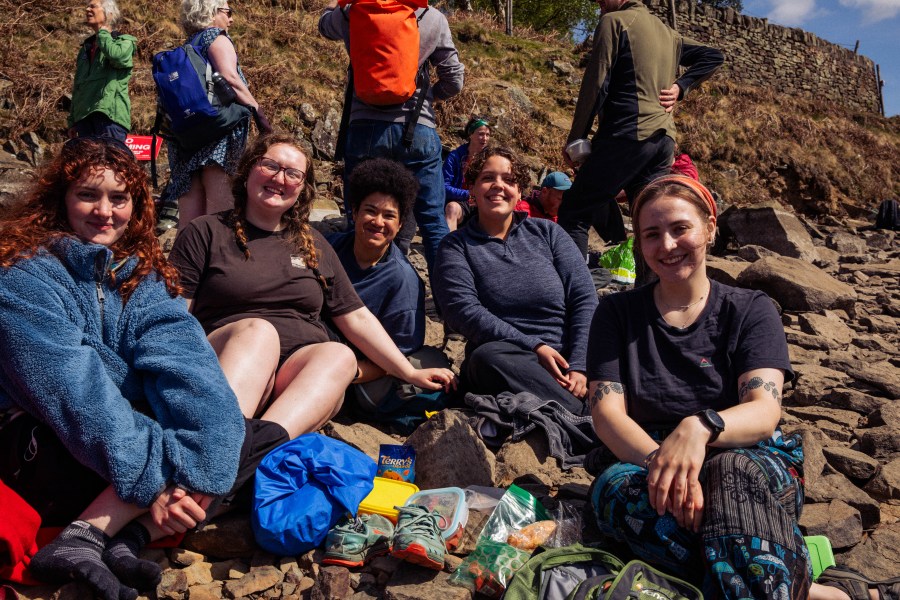
As I chatted with a local woman in her early 50s who said she swam here year round, I wondered why United Utilities (who own Kinder Reservoir) hadn’t already changed from deterrent to management as a strategy. It might win them some friends, which they badly need in the court of public opinion. A least-restrictive approach which informs the public and provides us with agency is the safer policy, as well as allowing for more personal freedom and giving us the tools to improve our own health.
People are already ignoring draconian access rules en masse; it’s time to acknowledge that and do right by public access. It’s time for them to see us. Making outdoor swimming more exclusive, less accessible with additional fencing, cameras, more threatening signs and gesticulating security guards doesn’t make it safer. It does the opposite, choosing to invest in exaggeration over information and fear over trust.
So how about it? Let’s move away from PR companies, signs, and surveillance, and towards education, building trust, and affirming the public’s desire to go for a quick swim in their local reservoir, however cold it might be. And with all the cash saved from the security guard budget, let’s put in a diving board or two!
READ MORE: A Right to Roam in England and Wales now feels possible – but not thanks to new government policy

